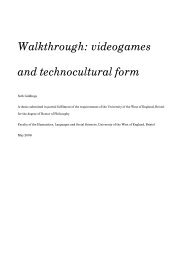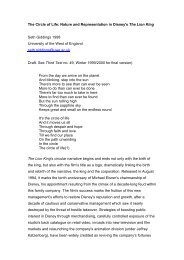“I'm the One Who Makes the Lego Racers Go ... - Seth Giddings
“I'm the One Who Makes the Lego Racers Go ... - Seth Giddings
“I'm the One Who Makes the Lego Racers Go ... - Seth Giddings
You also want an ePaper? Increase the reach of your titles
YUMPU automatically turns print PDFs into web optimized ePapers that Google loves.
and being a meta‐player (perhaps <strong>the</strong> computer or game‐system itself) in an actual<br />
game. O<strong>the</strong>r agencies are imaginatively displaced onto o<strong>the</strong>r human participants in <strong>the</strong><br />
shift from play in virtual to actual worlds.<br />
Reflecting on <strong>the</strong> findings of this little study, it became apparent to me that my<br />
microethnography is not just a variant of an existing set of methods, but ra<strong>the</strong>r that it<br />
facilitated, indeed necessitated, a more fundamental rethinking of <strong>the</strong> proper objects of<br />
ethnographic research. The micro‐events and relationships identified here cannot be<br />
separated out into familiar dynamics or entities. It becomes clear, for example, that<br />
videogame players are acted upon as much as <strong>the</strong>y act, that <strong>the</strong>y must work out what<br />
<strong>the</strong> machine wants <strong>the</strong>m to do (or what it will allow <strong>the</strong>m to do) as well as engage with<br />
it imaginatively. A key term to understanding children’s play on and off‐line is thus<br />
agency (ra<strong>the</strong>r than subjectivity), an agency that cannot be restricted to discussions only<br />
of <strong>the</strong> human participants. We must also inquire as to who or what <strong>the</strong> agents are in<br />
<strong>the</strong>se circuits, and develop conceptual resources that can be called upon to allow new<br />
media studies to identity and study <strong>the</strong>m. However, this emphasis on describing and<br />
<strong>the</strong>orizing <strong>the</strong> operations, agencies and effects of nonhuman participants in children’s<br />
videogame play should not lead us to disregard concerns about human desires,<br />
anxieties, identifications, and investments as players in <strong>the</strong>se media technocultural<br />
events. As we saw earlier in this chapter <strong>the</strong> different games were spun into being<br />
through <strong>the</strong> tastes, personalities, and abilities— technicities—of <strong>the</strong> two boys as well as<br />
<strong>the</strong> material affordances of computer hardware and software simulacra (Dovey &<br />
Kennedy, 2006). If code and information must be understood as real, material, of <strong>the</strong>




